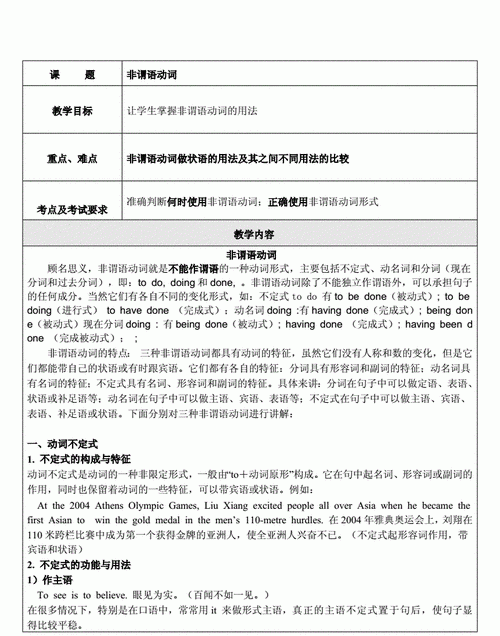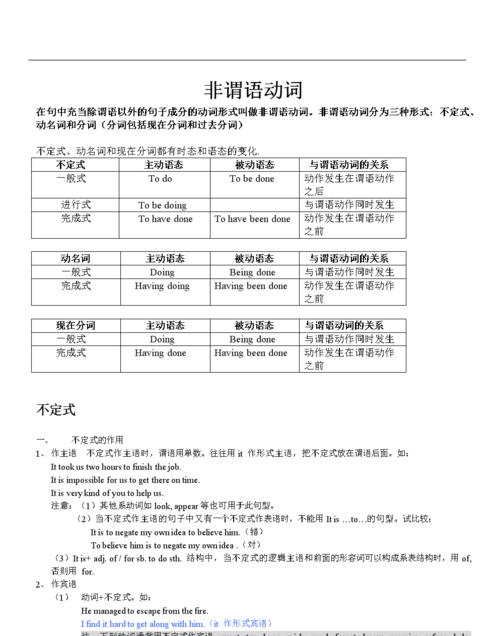本文目录
非谓语动词的讲解视频
非谓语动词题型的逻辑思维
1. 找出句子(以句号为划分标准),找出主语,谓语和宾语。
2. 如果一个句子中已经有一个动词了,还需要填入另外一个表示动作的词,那么这个动词就要用非谓语语态(动词不定式、现在分词、过去分词、动名词)。
3. 看主语和所需要填入的动作的关系,如果是主动语态的话,就填动名词形式(- ing形式),如果是主动与被动的关系的话,就填入被动语态(be+done 形式)。
4. 检查时态的正误。看句子中的谓语和非谓语动词,完成式表示的动作则在谓语动词所表示的动作之前已经完成, -ing形式表示两个动作同时发生, to do的形式有表将来的意义。

非谓语动词语法讲解ppt
非谓语动词通常有三种形式构成:
一是由“to+动词原形”而成的不定式
二是由“动词原形+ing”而成的现在分词或动名词
三是由“动词原形+ed”而成的,包括动词的不规则变化的过去分词
非谓语动词是指由动词变化而成,仍具有动词的性质与意义,但不能作为动词使用的词。

定义:非谓语动词也叫做非限定动词,其是指在句子中不是谓语的动词,主要包括了不定式、动名词和分词(现在分词和过去分词),也就是动词的非谓语形式。它除了不能独立作谓语外,还可以承担句子的其他成分。
详细解释:
(1)to do:当表示以及各结构时,就是表示将要发生的动作,do代表动词的原形,如果do是实义动词的话,意思就是“要去做”。
(2)doing:当表示以及各结构时,就是表示进行时态,例如:过去和现在进行时,或者动名词,doing代表动词后要加ing。
(3)done:当表示知以及各结构时,就是表示动词的过去分词,要用完成时have或had。

非谓语动词与谓语动词的区别:
1、谓语动词可以在句中单独作谓语,而非谓语动词不可以单独作谓语。
2、谓语与非谓语的形式不一样,谓语主要有16种基本时态(含被动),而非谓只有3种固定形式(被动和完成)。
3、谓语动词受主语的人称和数的限制,而非谓语动词形式是没有这种限制。
高中非谓语动词语法讲解
非谓语动词 知识要点: 一、非谓语动词种类及句法功能(一)概述: 在英语中,不作句子谓语,而具有除谓语外其他语法功能的动词,叫做非谓语动词。非谓语动词有动词不定式(the Infinitive);动名词(the Gerund);现在分词(the Present Participle);过去分词(the Past Participle)。 1、非谓语动词与谓语动词的相同点有: 1)如果是及物动词都可与宾语连用,例如: They built a garden. They suggested building a garden. 2)都可以被状语修饰: The suit fits him very well. The suit used to fit him very well. 3)都有主动与被动, “体”式(一般式;进行式;完成式)的变化。例如: He was punished by his parents.(谓语动词被动语态) He avoided being punished by his parents.(动名词的被动式) We have written the composition.(谓语动词的完成时) Having written the composition, we handed it in.(现在分词的完成式) 4)都可以有逻辑主语 They started the work at once.(谓语动词的逻辑主语) The boss ordered them to start the work.(动词不定式的逻辑主语) We are League members.(谓语动词的主语) We being League member, the work was well done.(现在分词的逻辑主语) 2、非谓语动词与谓语动词的不同点有: 1)非谓语动词可以有名词作用(如动词不定式和动名词),在句中做主语、宾语、表语。 2)非谓语动词可以有形容词作用(如动词不定式和分词),在句中做定语、表语或宾语补足语。 3)非谓语动词可以有副词作用(如动词不定式和分词),在句中作状语。(二)非谓语动词的句法功能: 句子成分非谓语 主语 表语 宾语 补语 定语 状语 同位语不定式üüüüüüü动名词üüü(极少)ü ü现在分词 ü üüü 过去分词 ü üüü 二、非谓语动词用法:(一)动词不定式:(to)+do,具有名词、形容词、副词的特征。 1、不定式的形式: 主 动被 动一般式to writeto be written进行式to be writing/完成式to have writtento have been written 否定式:not + (to) do 1)一般式:不定式的一般式所表示的动作与谓语动词动作同时发生或发生在谓语动词动作之后,例如: I’m glad to meet you. He seems to know a lot. We plan to pay a visit. He wants to be an artist. The patient asked to be operated on at once. The teacher ordered the work to be done. 2)进行式:不定式的进行式所表示的动作与谓语动词动作同时发生,例如: The boy pretended to be working hard. He seems to be reading in his room. 3)完成式:不定式的完成式表示的动作发生在谓语动词动作之前,例如: I regretted to have told a lie. I happened to have seen the film. He is pleased to have met his friend. 2、不定式的句法功能: 1)作主语: To finish the work in ten minutes is very hard. To lose your heart means failure. 动词不定式短语作主语时,常用形式主语it作形式主语,例如上面两句可用如下形式: It is very hard to finish the work in ten minutes. It means failure to lose your heart. 2)作表语: Her job is to clean the hall. He appears to have caught a cold. 3)作宾语: 常与不定式做宾语连用的动词有:want, hope, wish, offer, fail, plan, learn, pretend, refuse, manage, help, agree, promise, prefer, 如果不定式(宾语)后面有宾语补足语,则用it作形式宾语,真正的宾语(不定式)后置,放在宾语补足语后面,例如: Marx found it important to study the situation in Russia. 动词不定式也可充当介词宾语,如: I have no choice but to stay here. He did nothing last Sunday but repair his bike. 动词不定式前有时可与疑问词连用,如: He gave us some advice on how to learn English. 4)作宾语补足语: 在复合宾语中,动词不定式可充当宾语补足语,如下动词常跟这种复合宾语: want, wish, ask, tell, order, beg, permit, help, advise, persuade, allow, prepare, cause, force, call on, wait for, invite. 此外,介词有时也与这种复合宾语连用,如: With a lot of work to do, he didn’t go to the cinema. 有些动词如make, let, see, watch, hear, feel, have等与不带有to的不定式连用,但改为被动语态时,不定式要加to, 如: I saw him cross the road. He was seen to cross the road. 5)作定语: 动词不定式作定语,放在所修饰的名词或代词后。与所修饰名词有如下关系: A)动宾关系: I have a meeting to attend. 注意:不定式为不及物动词时,所修饰的名词如果是地点、工具等,应有必要的介词,如: He found a good house to live in. The child has nothing to worry about. What did you open it with? 如果不定式修饰time, place, way,可以省略介词: He has no place to live. This is the best way to work out this problem. 如果不定式所修饰名词是不定式动作承受者,不定式可用主动式也可用被动式: Have you got anything to sent? Have you got anything to be sent? B)说明所修饰名词的内容: We have made a plan to finish the work. C)被修饰名词是不定式逻辑主语: He is the first to get here. 6)作状语: A)表目的: He worked day and night to get the money. She sold her hair to buy the watch chain. 注意不定式放句首时,逻辑主语与句子主语要一致: wrong:To save money, every means has been tried. right: To save money, he has tried every means. wrong:To learn English well, a dictionary is needed. right: To learn English well, he needs a dictionary. B)表结果: He arrived late to find the train gone. 常用only放在不定式前表示强调: I visited him only to find him out. C)表原因: They were very sad to hear the news. D)表程度: It’s too dark for us to see anything. The question is simple for him to answer. 7)作独立成分: To tell you the truth, I don’t like the way he talked. 8)不定式的省略:保留to省略do动词。 If you don’t want to do it, you don’t need to. 9)不定式的并列:第二个不定式可省略to。 He wished to study medicine and become a doctor.

高中英语非谓语动词讲解
高中英语合集百度网盘下载
链接:***/s/1znmI8mJTas01m1m03zCRfQ
提取码:1234
简介:高中英语优质资料下载,包括:试题试卷、课件、教材、视频、各大名师网校合集。

以上就是关于非谓语动词专题讲义,非谓语动词的讲解视频的全部内容,以及非谓语动词专题讲义 的相关内容,希望能够帮到您。

